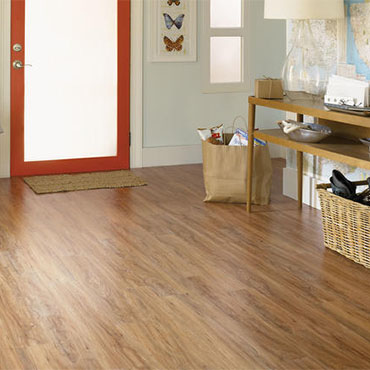Sustainable Interiors with a Modern Edge

With a wide range of stylish, environmental materials available, you can get home design that’s polished and visually stunning, while improving the health of your home—and the Earth.
Use Color and Texture to Indicate Transitions
Modern homes are designed less as a series of closed-off, individual rooms, and more as an open plan that flows from one area to the other. That puts more importance on well-articulated transitions, which help onlookers understand at a glance where one boundary blends into another. Contrasting flooring textures conjure up this visual understanding, partitioning the kitchen from the dining area, for instance, without walling either room off. Transitions can even be used to draw attention to a unique fixture or space—a dramatic slate-gray-hued tile installed under a fireplace, for instance, that leads your eye right to its edge.
Break Up Your Interiors with Organic Shapes
Not every flooring transition needs to be a hard line, however. Subtler, more organic divisions, such as hexagonal tiles laid below a tub in a large master bath, add dimension to a space without creating hard and fast boundaries. In fact, you can add to the effect by using a soft, eco-friendly material for your walls, such as tadelakt—a Moroccan lime plaster that creates rounded, visually-intriguing surfaces.
Dial Up Visual Drama with Natural and Industrial Pairings
One element that adds an interesting style to homes is the pairing of hard and soft surfaces, a look that’s easily captured by combining both industrial and natural elements in your decor. Concrete, recycled glass, and stainless steel counters, for instance, are considered to be some of the more environmentally friendly options available, and all lend your surfaces an industrial patina, giving you a check in the “hard” column. Combine them with softer, organic-feeling products, like wood-grain-patterned linoleum, for a super-sustainable kitchen redux that will last ten years or more.
Use Woodgrains as Geometric Patterning
Sustainable homes tend to celebrate all things outdoors, whether it’s through a big, spacious, energy-efficient window that looks out on the garden or beautiful wood pieces that let you appreciate the natural beauty of each grain. In particular, wood laid to mimic geometric patterns, like herringbone, adds an auspicious note of interest to your usual flooring options. Of course, milled wood comes at an environmental price—unsustainably harvested timber is directly responsible for much of the world’s deforestation. And the sealants and stains involved in finishing can release harmful VOCs into your home. Sustainable, asthma-friendly products, like Tarkett’s resilient sheet flooring, including their Preference® Plus and ValuePro™ lines, can get you the look without damaging your health—or the health of the planet.
Or Try Out Abstract Forms
An offbeat contender for our design-loving hearts, flooring tiles cut into varying, eclectic sizes bring a sophisticated, intriguing sensibility to a hallway, dining area, or sunroom. To capture the beautiful look of natural stone, try it in a small and contained area, like an entryway that leads out to the garden.
No matter how you choose to design it, your decor will definitely draw looks—and your commitment to the environment will be on full display.
About the Writer
Erin Vaughan is a blogger, gardener and aspiring homeowner. She currently resides in Austin, TX where she writes full time for Modernize.com, with the goal of empowering homeowners with the expert guidance and educational tools they need to take on big home projects with confidence.






























